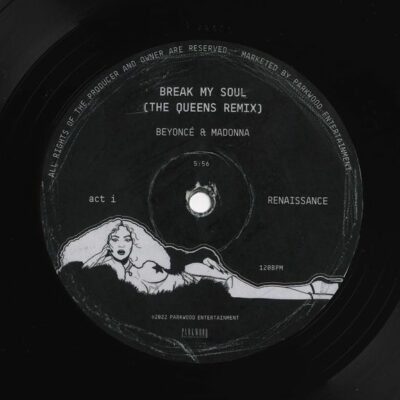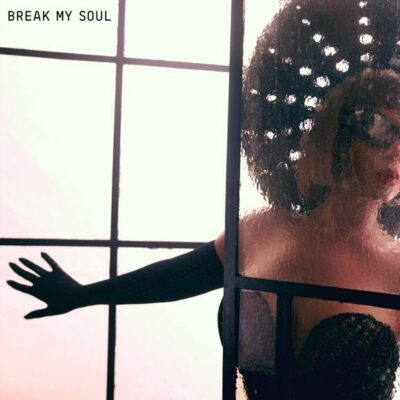Beyoncé went meta with her “Queens Remix” of lead single “Break My Soul” by interpolating Madonna’s “Vogue” into her instance classic House song, and I cannot stop devouring and dissecting it.
Somehow, Beyoncé just improved my favorite pop song of all time.
I’ve been spinning Beyoncé’s new record Renaissance for a few weeks now. If there’s one quick way to my music-loving heart, it’s to produce an album full of durable songs that’s dancefloor ready from front to back. While I’m not an official BeyHive member, but Beyoncé is on my list of artists of whom I keep a complete discography – so, I’ve had (and have heard) all of her songs.
My complete collection doesn’t usually extend to remixes, but in this case I made an exception. That’s because this remix of “Break My Soul” interpolates Madonna’s “Vogue” and ads a whole set of new lyrics from Beyoncé riffing on Madonna’s classic film star rap in the original song.
It’s well-established on this blog that “Vogue” is my personal gold standard of pop singles. When Madonna released it 32 years ago it struck me like a lightning bolt, as much for it message of finding acceptance on the dancefloor as for its House beat.
“Vogue” was Madonna’s first dabble in House music, thanks to co-writer and producer Shep Pettibone and his samples from The Salsoul Orchestra’s post-disco classic “Ooh I Love It (Love Break Groove).” Voguing itself was a NYC ballroom culture dance style that hadn’t broken through far into the mainstream at the time. It’s unsurprising Madonna would hear a house beat and think of the dance, but it was pure serendipity that she wound up making the word and the dance synonymous with House music across the world.
(This was memorably documented on the first episode of Season 2 of Pose, “Acting Up,” which gives a fictionalized glimpse at how the NYC ballroom scene initially reacted to Madonna’s track.)
As I’ve grown and learned more about house music, voguing, and ballroom, I realize that even though Madonna was using “Vogue” to shine a spotlight on ballroom culture, she was also appropriating it for her own use. It was the moment that marked her ascension to global dominance. She used that platform to preach acceptance and to raise awareness for HIV/AIDs, and she employed many dancers and choreographers along the way, but it’s not as though of all her success trickled down the people who were innovating Voguing in the ballroom scene.
There is nowhere this sticks out more to me than in her “rap” verse using spoken word to namecheck old film stars – most (if not all) white.
Greta Garbo and Monroe
Dietrich and DiMaggio
Marlon Brando, Jimmy Dean
On the cover of a magazineGrace Kelly, Harlow, Jean
Picture of a beauty queen
Gene Kelly, Fred Astaire
Ginger Rogers, dance on airThey had style, they had grace
Rita Hayworth gave good face
Lauren, Katherine, Lana too
Bette Davis, we love you
As an eight-year-old in 1990, I was obsessed with this list of 17 classic stars. Who were they? Why were they significant? It gave me something to talk about with my grandparents, and lead me to become a fan of Marilyn Monroe.
Yet, this verse has always been out of place in Madonna’s song about how the dancefloor erases gender and color – possibly because of the song’s viewpoint that the dancefloor erases gender and color.
With decades of hindsight and education, the verse seems at odds with the rest of the song. I understand that Madonna is referencing the snapshot quality of the poses in Voguing and drawing an allusion to the crisp, classic quality of the black-and-white film era. That’s a literal whitewashing of a modern trend established and championed by black artists.
That’s why I am so incredibly obsessed with Beyoncé’s new remix of “Break Your Soul.” She doesn’t just interpolate “Vogue” – she completely re-writes it.
Beyoncé issues an update to Madonna’s spoken word that is twice as long, using it to celebrate a litany of 30 black pop stars of the past 100 years, as well as name-checking a list of 12 prominent ballroom houses – most of which were founded by queer people of color and which have existed since before the release of Madonna’s song 32 years ago.
Rosetta Tharpe, Santigold
Bessie Smith, Nina Simone
Betty Davis, Solange Knowles
Badu, Lizzo, Kelly Rowl’Lauryn Hill, Roberta Flack
Toni, Janet, Tierra Whack
Missy, Diana, Grace Jones
Aretha, Anita, Grace JonesHelen Folasade Adu, Jilly from Philly, I love you, boo
Don’t just stand there, get in to it
Strike a pose, there’s nothing to it
VogueMichelle, Chlöe, Halle, Aaliyah
Alicia, Whitney, Riri, NickiHouse of Revlon, House of LaBeija
House of Amazon, the House of Aviance
House of Balmain, the House of NinjaThe House of Lanvin, House of Telfar
House of Ladosha, House of Mugler
The House of Balenciaga, the House of Mizrahi
I had no idea of what I expect when I first spun this “Queens Remix” a few weeks ago. I thought Madonna might show up in a sample or to double a vocal like she did on Dua Lipa’s “Levitating.” I got chills when the song opened with the recognizable string sample from “Vogue,” but I full-on bawled over Beyoncé’s update to the spoken word verse ending with Madonna’s iconic declaration “Strike a pose, there’s nothing to it!”
There are 8-year-olds today that are going to use this as their map of musical discovery just as I did with film back in the 90s. Heck, I think there are 40-year-olds who will likely do the same. And, now these ballroom houses who helped innovate Voguing before Madonna elevated its status are getting the name-checks and attention they have always richly deserved.
I am so happy this version of “Vogue” now exists in the world. I don’t think Beyoncé’s verse should replace Madonna’s, which was meant as a celebration and should still be appreciated as such. But, for me, Beyoncé’s own celebration focused on black and queer people who laid a path for “Vogue” and continued to innovate in its wake immediately became an integral part of my love for both “Vogue” and “Break My Soul.”